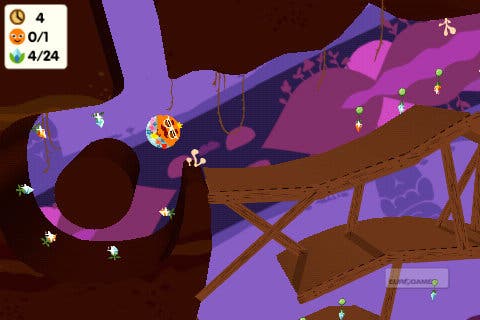Rolando 2
In bloom.
Rolando 2's world is without blemish. Every cloud, tree and roly-poly blob of a character is piped in perfect Pantone, as if someone took away all of Jackson Pollock's flick brushes and instead made him squeeze paint like icing in steady dollops onto the page. It's still pure LocoRoco, of course, but somehow LocoRoco with the contrast turned up: French mustard yellows becoming brilliant suns and petit-pois hills turned deep evergreen.
This near-sterile sort of flawlessness is mirrored too in the game's systems, which, while narrow in scope and ambition, are self-assured. The Rolandos roll smooth and true as you shepherd them toward each level's exit with sometimes-careful and sometimes-exaggerated tilts of the iPhone. The touch-screen controls are economic: tap the screen to advance dialogue, draw boxes over groups or individual Rolandos to select them RTS-style and make jerky upward flicks to jump obstacles. Everything works as it should do, the game excelling in the sort of effortless, intuitive function that comes from a Nintendo-esque attention to interaction.
Of course, it's the game's context that makes you want to applaud these modest triumphs. iTunes may have democratised game publishing but when you open your platform to the world, expectations of what might be possible are soon lowered by a hundred thousand fart apps, Bejeweled clones and two-minute sub-Flash game novelties. The first Rolando was a gemstone in the rubble, a simple, clean game that mightn't have drawn much attention if it appeared on a more traditional handheld, but which, in the context of iPhone's library of mixed amateurism, shone like the greatest game ever made, or, at very least, the most professionally-crafted one.
But in truth it was neither. While Rolando displayed ngmoco and HandCircus's unrivalled appreciation of the iPhone and iPod Touch's unique abilities, it was defined as much by restraint as by ambition. The short, snappy levels were ideal for gaming on the go, but their length made every play session feel like snacking, something exacerbated by the slightly pedestrian level design that prided muted consideration over raw spectacle.

Rolando 2 is, on almost all of these counts, an improvement. Levels are, if anything, more tightly wound and precise than before, the volley of 45 stages coming fast and frequent towards the determined player. But they are, in general, better thought out and executed than before, the designers more clear on what they wanted to achieve with each and, for that reason, the learning curve is a distinguished one, leading players old and new by the hand into the deep end.
This time around, the game's cushioned into a cute story, a quest to save an island's royal Rolandos from a ravaging sickness. The only cure for the Kilogorean flu, as the islanders know it, is a rare golden orchid, which you roll off in search of through a variety of south-sea hot locations. As well as the stock flick-to-jump move your fingers must be employed to activate numerous contraptions to move them towards each level's exit. The swipe-controlled yellow lifts and springboards from the first game make a more refined return, as does the explosive fruit, which must be tapped from a tree's branches and used to blast through walls and enemies.








